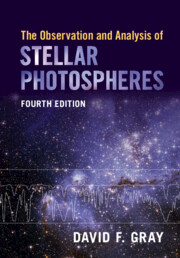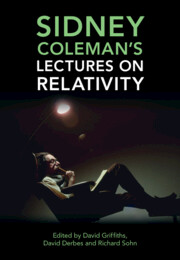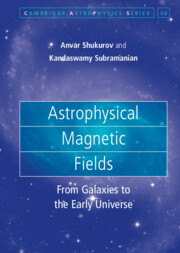Refine listing
Actions for selected content:
16950 results
4 - The Principle of Equivalence
- from Part II - General Relativity
-
- Book:
- Sidney Coleman's Lectures on Relativity
- Published online:
- 23 December 2021
- Print publication:
- 13 January 2022, pp 95-99
-
- Chapter
- Export citation
Frontmatter
-
- Book:
- Sidney Coleman's Lectures on Relativity
- Published online:
- 23 December 2021
- Print publication:
- 13 January 2022, pp i-iv
-
- Chapter
- Export citation
8 - Conservation and Cosmology
- from Part II - General Relativity
-
- Book:
- Sidney Coleman's Lectures on Relativity
- Published online:
- 23 December 2021
- Print publication:
- 13 January 2022, pp 200-219
-
- Chapter
- Export citation

The Observation and Analysis of Stellar Photospheres
-
- Published online:
- 05 January 2022
- Print publication:
- 16 December 2021
-
- Textbook
- Export citation

Sidney Coleman's Lectures on Relativity
-
- Published online:
- 23 December 2021
- Print publication:
- 13 January 2022

Astrophysical Magnetic Fields
- From Galaxies to the Early Universe
-
- Published online:
- 23 December 2021
- Print publication:
- 16 December 2021
13 - The Behavior of Spectral Lines
-
- Book:
- The Observation and Analysis of Stellar Photospheres
- Published online:
- 05 January 2022
- Print publication:
- 16 December 2021, pp 280-303
-
- Chapter
- Export citation
6 - The Fluctuation Dynamo
-
- Book:
- Astrophysical Magnetic Fields
- Published online:
- 23 December 2021
- Print publication:
- 16 December 2021, pp 171-206
-
- Chapter
- Export citation
14 - The Measurement of Stellar Radii and Temperatures
-
- Book:
- The Observation and Analysis of Stellar Photospheres
- Published online:
- 05 January 2022
- Print publication:
- 16 December 2021, pp 304-335
-
- Chapter
- Export citation
Index
-
- Book:
- The Observation and Analysis of Stellar Photospheres
- Published online:
- 05 January 2022
- Print publication:
- 16 December 2021, pp 507-514
-
- Chapter
- Export citation
3 - Observational Signatures of Magnetic Fields
-
- Book:
- Astrophysical Magnetic Fields
- Published online:
- 23 December 2021
- Print publication:
- 16 December 2021, pp 68-120
-
- Chapter
- Export citation
15 - The Measurement of Surface Gravity
-
- Book:
- The Observation and Analysis of Stellar Photospheres
- Published online:
- 05 January 2022
- Print publication:
- 16 December 2021, pp 336-353
-
- Chapter
- Export citation
5 - The Concept of Hydromagnetic Dynamo
-
- Book:
- Astrophysical Magnetic Fields
- Published online:
- 23 December 2021
- Print publication:
- 16 December 2021, pp 160-170
-
- Chapter
- Export citation
18 - Stellar Rotation
-
- Book:
- The Observation and Analysis of Stellar Photospheres
- Published online:
- 05 January 2022
- Print publication:
- 16 December 2021, pp 439-487
-
- Chapter
- Export citation
Frontmatter
-
- Book:
- Astrophysical Magnetic Fields
- Published online:
- 23 December 2021
- Print publication:
- 16 December 2021, pp i-iv
-
- Chapter
- Export citation
1 - Introduction
-
- Book:
- Astrophysical Magnetic Fields
- Published online:
- 23 December 2021
- Print publication:
- 16 December 2021, pp 1-4
-
- Chapter
- Export citation
15 - Magnetic Fields in the Early Universe
-
- Book:
- Astrophysical Magnetic Fields
- Published online:
- 23 December 2021
- Print publication:
- 16 December 2021, pp 471-518
-
- Chapter
- Export citation
16 - Signatures of Primordial Magnetic Fields
-
- Book:
- Astrophysical Magnetic Fields
- Published online:
- 23 December 2021
- Print publication:
- 16 December 2021, pp 519-547
-
- Chapter
- Export citation
14 - Magnetohydrodynamics of Galaxy Clusters
-
- Book:
- Astrophysical Magnetic Fields
- Published online:
- 23 December 2021
- Print publication:
- 16 December 2021, pp 447-470
-
- Chapter
- Export citation
Appendix B - Approximate Physical Parameters of Stars
-
- Book:
- The Observation and Analysis of Stellar Photospheres
- Published online:
- 05 January 2022
- Print publication:
- 16 December 2021, pp 489-492
-
- Chapter
- Export citation
